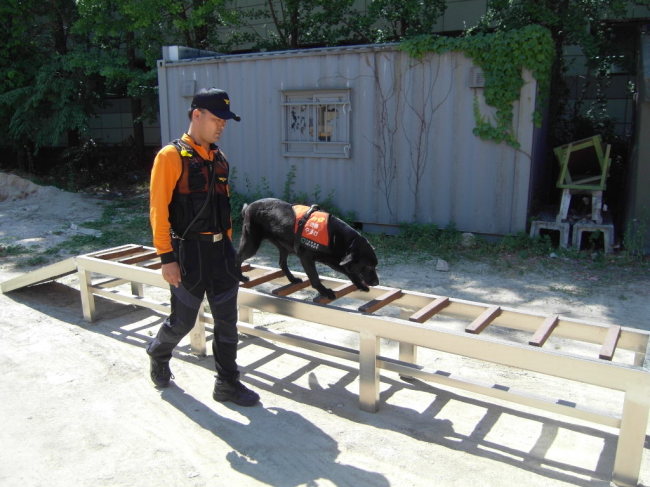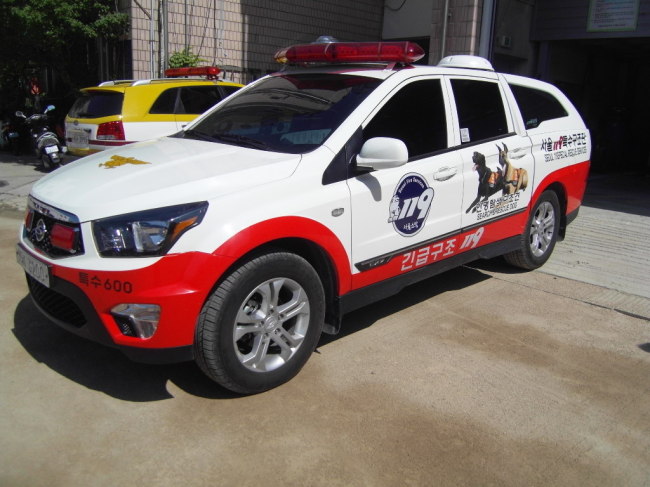[Weekender] Dogs are colleagues to emergency rescue workers
Rescue dog Moran on call 24/7 to search for missing people
By Park Hyung-kiPublished : June 12, 2015 - 21:36
Moran, a black Labrador retriever, can do more than just sit and roll over.
She has special skills that no human and most pet dogs lack.
With a keen sense of smell, the 30-kilogram Lab can track down missing persons miles away who are trapped in natural disaster areas or deep in the mountainous woods. She can help firemen and police solve mysteries on whether the missing victims are alive or dead.
Moran is a rescue dog for the Special Rescue Team in Dobong-gu. The team, which works closely with the Dobong Fire Service, is part of the Seoul Metropolitan Fire & Disaster Headquarters, which operates under the National 119 Rescue Services based in Daegu.
With a record of finding three missing persons and one accident victim since being dispatched to the team two years ago from the 119 headquarters, Moran is a valuable asset not only to the unit but also to her partner Park Dae-joon.
“We say Moran is a ‘colleague.’ In fact, rescue dogs are not animals, but classified as ‘special high-tech equipment,’ which we have to handle with extreme care,” said Park Dae-joon, Moran’s personal K-9 operative or handler.
“Simply put, she has to be treated like you and me.”
She has special skills that no human and most pet dogs lack.
With a keen sense of smell, the 30-kilogram Lab can track down missing persons miles away who are trapped in natural disaster areas or deep in the mountainous woods. She can help firemen and police solve mysteries on whether the missing victims are alive or dead.
Moran is a rescue dog for the Special Rescue Team in Dobong-gu. The team, which works closely with the Dobong Fire Service, is part of the Seoul Metropolitan Fire & Disaster Headquarters, which operates under the National 119 Rescue Services based in Daegu.
With a record of finding three missing persons and one accident victim since being dispatched to the team two years ago from the 119 headquarters, Moran is a valuable asset not only to the unit but also to her partner Park Dae-joon.
“We say Moran is a ‘colleague.’ In fact, rescue dogs are not animals, but classified as ‘special high-tech equipment,’ which we have to handle with extreme care,” said Park Dae-joon, Moran’s personal K-9 operative or handler.
“Simply put, she has to be treated like you and me.”

The team also has a Malinois Belgian shepherd named Mac, who was away on a mission with his partner. Labrador retriever and Malinois rescue dogs can also be trained as sniffer dogs to detect illicit substances at airports, or police dogs to hunt down fugitives. White Labradors are commonly trained as guide dogs for the blind, and black ones for fire and police services.
Like firemen or policemen, Moran is on call 24/7 and needs to train three hours a day ― two hours of basic training such as obedience and detection exercises, and one hour of physical training.
Her daily exercise includes tracking down a person hidden in building rubble after going over and through obstacles. She also goes to nearby mountains such as Dobongsan and Suraksan to enhance her search and rescue capability.
“Through these exercises, Moran will be able to boost her memories, senses and skills,” Park said.
“Rescue dogs like Moran track down missing survivors or victims by remembering the smell of human DNA given that people smell alike.”
When she finds that person, she wags her tail and barks as loud as she can so that her partner can hear from far away. A handler and a rescue dog maintain a distance of 200-300 meters from each other during a search.

Like people, she exercises only in the morning and evening in the summer as it is hard to train under the scorching heat. She has to relax in a stress-free environment because she needs to be in the very best condition for real-life rescue situations.
This is why rescue dogs need to stay in a spacious facility with air conditioners and heaters.
They also have to ride inside specially designed vehicles with air conditioning and ventilation systems when heading to the scene of an accident or disaster.
There are 22 rescue dogs in Korea, and 12 are being trained to become part of the emergency teams nationwide.
“They deserve more credit than we know,” said Park.
By Park Hyong-ki (hkp@heraldcorp.com)



![[Herald Interview] 'Amid aging population, Korea to invite more young professionals from overseas'](http://res.heraldm.com/phpwas/restmb_idxmake.php?idx=644&simg=/content/image/2024/04/24/20240424050844_0.jpg&u=20240424200058)












![[KH Explains] Korean shipbuilding stocks rally: Real growth or bubble?](http://res.heraldm.com/phpwas/restmb_idxmake.php?idx=652&simg=/content/image/2024/04/25/20240425050656_0.jpg&u=)

